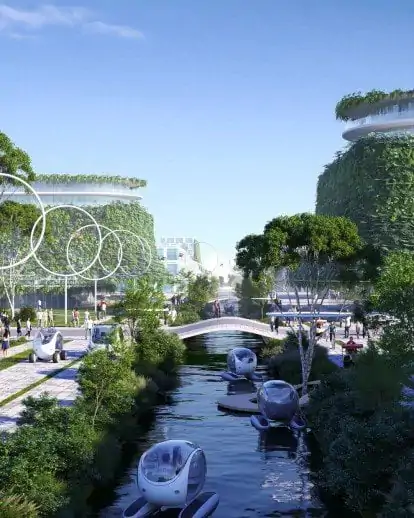Bjarke Ingels has always pushed boundaries and turned ambitious concepts into reality, always contemplating sustainability in its architectural structures. And this project in particular shows us the beauty of a green future.
BiodiverCity is a sustainable city of three islands connected by autonomous vehicles by land, water and air. An archipelago city off the coast of Malaysia that forms a transport-emission-free habitat.

Three BiodiverCity islands will be built in Penang and will serve as cultural, commercial and residential hubs.
BiodiverCity moves all independently
The most surprising thing about the development of this sustainable city is that all transport on BiodiverCity's 1820 hectares will consist of totally autonomous boats, vehicles and aircraft. The islands will be car and pedestrian free.

Construction is one of the largest sources of carbon emissions: even more than the aviation industry. So to reduce the impact on the environment, most buildings will be prefabricated or 3D printed on site and others will use a combination of bamboo, Malaysian wood and “green concrete” made from recycled materials.
The commercial part of BiodiverCity is still ongoing, but will ultimately consist of three islands: channels, the mangroves and the Lagoon.

The first island is a paradise that will include 4,6 kilometers of beaches, 2,4 square kilometers of parks and 25 kilometers of waterfront.
The mangroves they will be made for business and events with a special space called Bamboo Beacon to host conferences or concerts. Finally, the Lagoon it will be a group of eight small islands built around a marina and it is here that people will be able to live in houseboats, on stilts or terraces.

The three islands will be made up of different "districts" which will host around 16.000 people in total. The “urban water lilies” connected to each other and all the islands will be able to exploit the resources locally.
Sustainable city to coexist and thrive
BiodiverCity will be designed to be a sustainable city where people and nature not only coexist but thrive. To keep native animals safe in places inhabited by humans, builders will also include canopies, waterways and walkways. In line with this strong green approach, there will also be green roofs and open spaces to create a symbiotic relationship between people and nature.
We are literally on a journey to create more Malaysia for future generations. We have decided to set the level as high as humanly possible by imagining a new archipelago that aims to be both culturally and biologically more diverse than previous developments
Bjarke Ingels, founder of the BIG studio
The islands will be integrated with a SMART network that provides residents with real-time data on waste, energy consumption and more. This will help the BiodiverCity community make informed decisions regarding the sustainable city.

The channels will have a digital park for researchers, educators, families and business people with virtual reality and robotics being the new norm in cities of the future.
“Our masterplan proposal, BiodiverCity, supports the vision of Penang2030 with clear values. Liveability, socially and economically inclusive development and environmental sustainability for future generations,” says Bjarke Ingels, founder of BIG.
Check out this crazy video and tell me you don't want to live in it:


